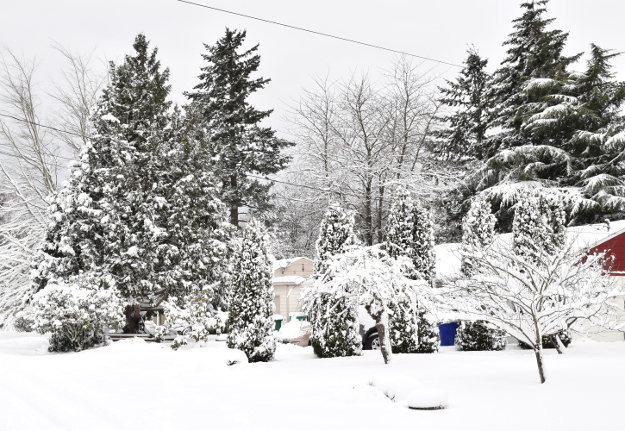
Portland has had a horrendous winter. Multiple ice storms, lower than average temperatures, and a single freak snowstorm that dumped nearly a foot of snow have taken a toll, and not just on our spirits. Plants have been heaved out of the ground, broken in two, killed outright by cold.
This is good news for nurseries, as people will be heading to the garden centers this spring in search of replacements. On Facebook, I’ve noticed that several people have mentioned that fact to my friend Paul Bonine, co-owner of Xera Plants, a wholesale/retail nursery that serves the Portland area.
However, Paul never accepts that news as consolation.
“I want people to succeed,” he says. He would rather see gardeners grow plants that are supremely adapted to local conditions and not lose any plants. As a nurseryman, he is always looking for new plants AND always testing them to determine if they are well suited to our climate. This winter will be another test.

The Xera Plants retail shop at 1114 SE Clay St. will open for business this Saturday, February 11 at 10am. I went down to their wholesale nursery today to get a sneak peak at their first batch of climate-adapted plants, and Brandon (seen here), John, and co-owner Greg Shepherd were loading the truck with goodies. Here’s a little of what you will find if you go to Xera this Saturday.

If Helleborus Golden Sunrise doesn’t get you out of your winter funk, then I don’t know what will. Xera also has some gorgeous Apricot Blush and some other colors. These hellebores were bred right here in Oregon by the legendary Ernie and Marietta O’Byrne. They need a shady spot and occasional water in the summer.
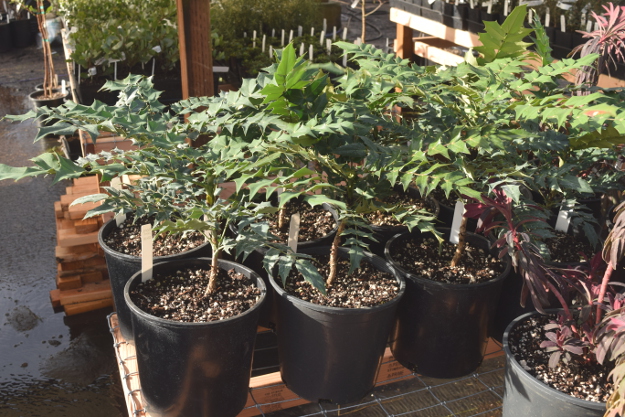
Mahonia ×media ‘Charity’ had recently finished up blooming.

I have one of these and it powered through the ice and snow, giving the poor overwintering hummingbirds some valuable nourishment. ‘Charity’ prefers part shade and is drought tolerant once established. It reaches 12 ft. by 8 ft. The only thing I don’t like about it is that the spines on the leaves are wickedly sharp, but luckily it doesn’t need much grooming. Hardy to zone 7.
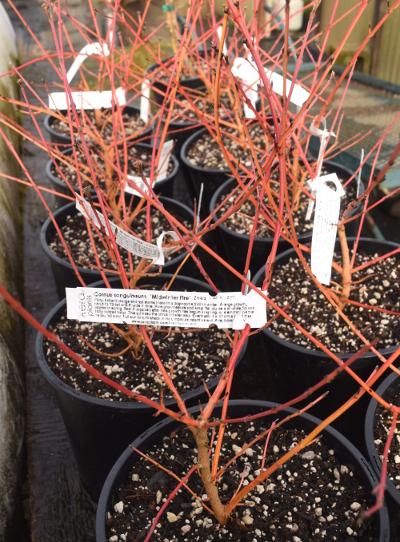
Even people who aren’t into red twig dogwoods like Cornus sanguinea ‘Midwinter Fire’. This one stands out from the pack with especially vibrant orange and red two-tone twigs. Probably best to coppice it (cut it back almost to the ground) to control its size and promote the best color. Give it plenty of water if you can. Hardy to zone 4a.
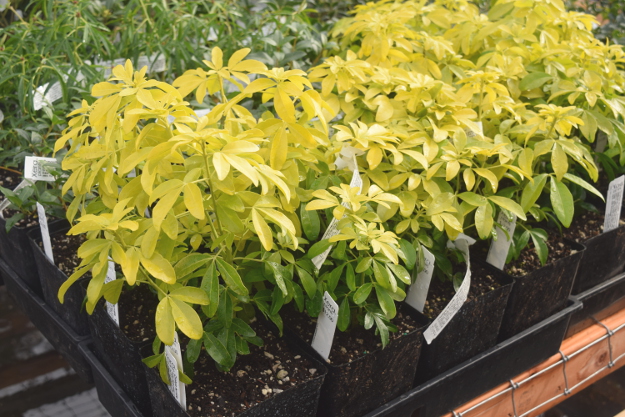
Choisya ternata ‘Sundance’ Mexican orange was all aglow. This cheery shrub adds a nice pop of color to lightly shaded gardens. It appreciates a bit of shelter (it is hardy only to zone 8a), and if it does sustain some damage, it can be cut back now, in February.
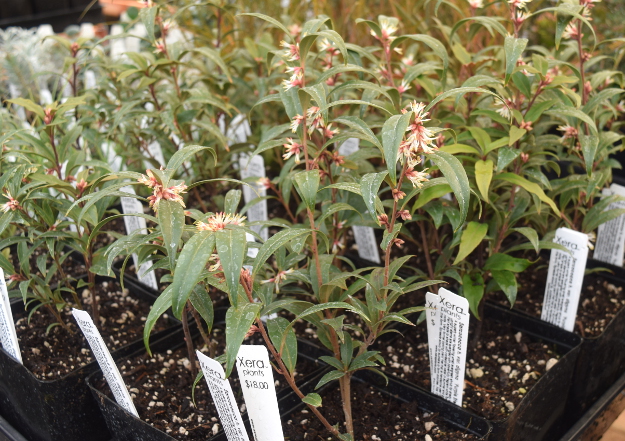
Purple stem sweet box (Sarcococca hookeriana var. digyna) will give you an olfactory pick-me-up. This wonderful winter bloomer also likes shade, and it appreciates regular water. It grows to about 2 ft. in height and will spread by suckering, but not obnoxiously. Hardy to zone 7a.
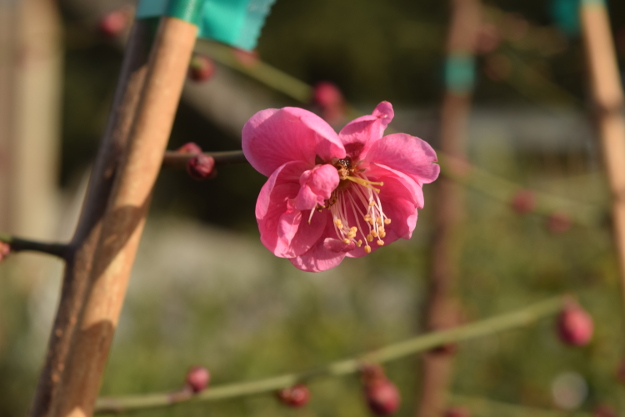
I didn’t realize that the Japanese flowering apricot (Prunus mume ‘Kobai’) was so fragrant until Greg pointed it out to me today. There was only one flower open, and it smelled like candy. This makes a lovely small tree. Supposedly hardy to zone 6, though I almost never saw it in zone 6 Cincinnati. It is glorious in Portland.
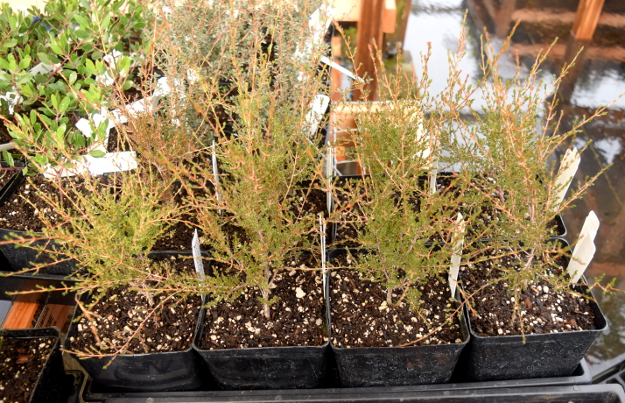
This is a fun scratch-and-sniff. Do you know heathmyrtle (Baeckea gunniana)? It is a heath and heather relative from Tasmania with a minty-spicy scent. It gets teeny white blossoms in early summer and likes full sun and regular water. Hardy to zone 7b.
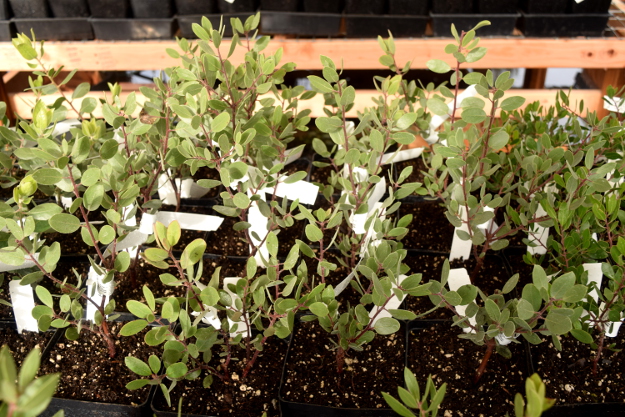
If you’re doing a low-water garden or even a no-water garden, you’re going to want some manzanitas (Arctostaphylos), and Xera is the place to get them. This is one I have, Arctostaphylos bakeri ‘Louis Edmonds’. They have quite a few other varieties ready for sale. A. pajaroensis ‘Myrtle Wolf’ and A. densiflorus ‘Type Form’ were looking especially good.
If you’re interested in manzanitas, but don’t know which one to get, just tell the guys at the shop what your conditions are and what look you’re after, and they’ll steer you right. Don’t worry that the plants are small. You want to start with a small one. Large plants will just wind rock before they have a chance to root in, and they grow fast anyway.
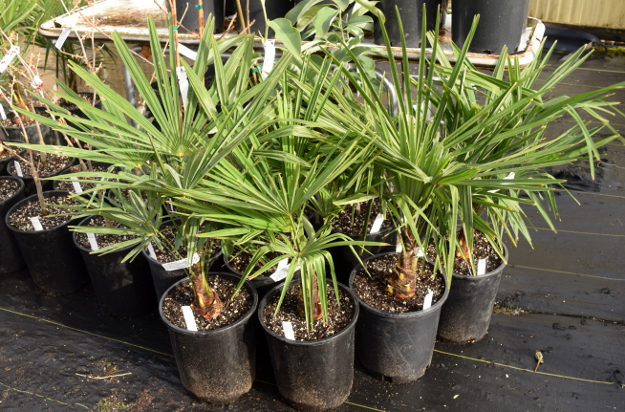
Xera has some handsome windmill palms (Trachycarpus fortunei).
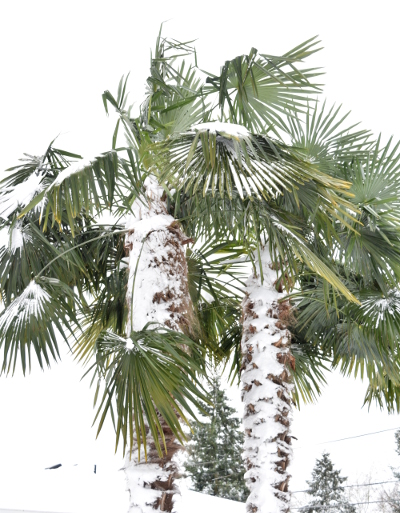
Although they look tropical, windmill palms are hardy west of the Cascades and are a common sight in Portland. They like good, fertile soil and regular irrigation.

We used to grow Polystichum polyblepharum in the Midwest, and I thought it was the prettiest fern at the nursery. I never saw it planted out, but it was glossy and perfect in containers. We called it tassel fern like everybody else; Xera has to be a little different and call it “eyelash fern.” Apparently polyblepharum means “many eyelashes.” Who knew? Dappled shade, regular water, zone 6a.
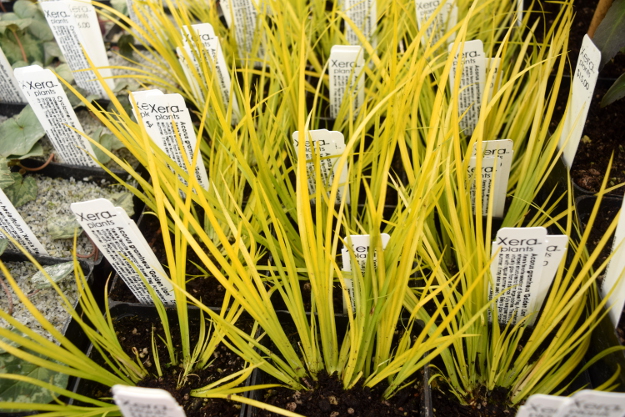
In moist to wet soil, sweet flag (Acorus gramineus) always looks good, and this ‘Golden Lion’ selection is electric on dreary, drizzly winter days. It would be great in a pot, too. Easy peasy, hardy to zone 5b.

I would not be without silver spurge (Euphorbia rigida).

Here it is in Greg’s garden. Full, baking sun, no water. I’m really crazy about this plant—the beautiful architecture of the stems and leaves, the early chartreuse flowers (the seedheads turn hot pink on some of Greg’s), the compact size, the evergreen nature. It reseeds, but not too much. Zone 7a.
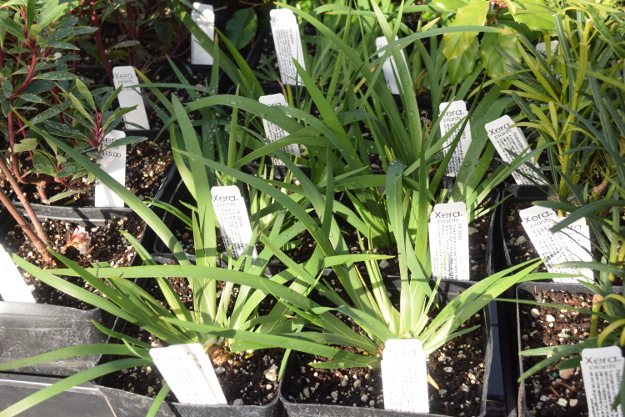
Iris lazica is for sale again this year.
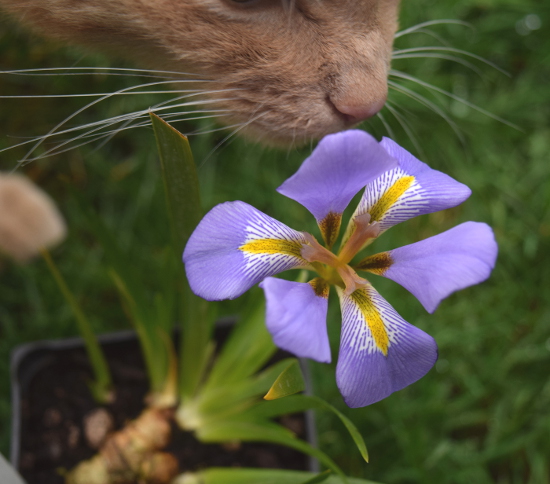
I got one last year, and it passed inspection from George the Cat. Iris lazica used to be a subspecies of the winter-flowering Iris unguicularis. Beautiful flowers are just the beginning. How about evergreen and tolerant of extremely dry, dense shade? Hardy to zone 6a, too.
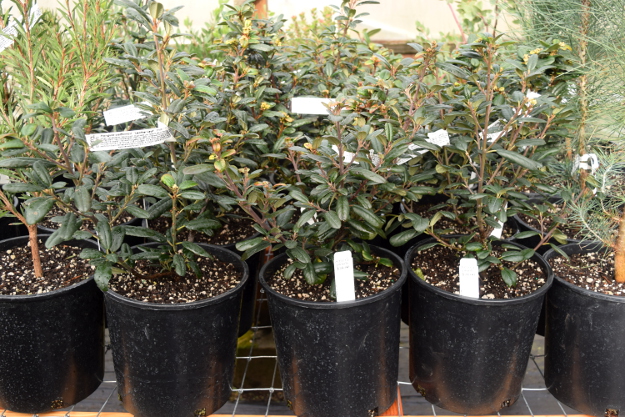
I’m very intrigued by coffee berry (Frangula californica ‘Leather Leaf’). This California/Oregon native evergreen shrub is incredibly drought tolerant and hardy to zone 6b. Very dapper foliage, plus berries for the critters!
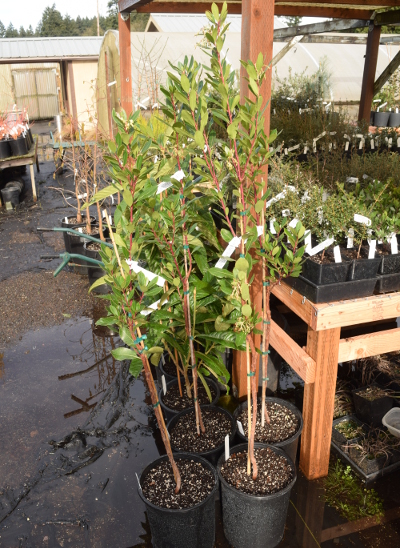
I think strawberry tree (Arbutus unedo) is amazing, because eventually it does this…
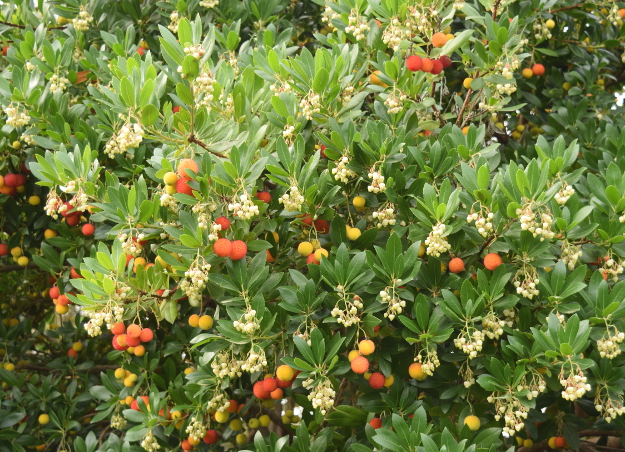
in October no less! Strawberry tree is very drought tolerant, just like our native madrone, to which it is related. It is hardy to zone 7b.
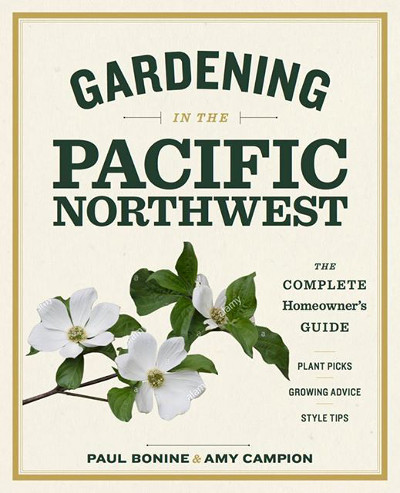
Xera Plants really is my favorite nursery, but I am a little biased. Paul and I are co-authoring Gardening in the Pacific Northwest: The Complete Homeowner’s Guide. It will be out in November 2017 from Timber Press.
See you this weekend at Xera!


The Cronus ‘Midwinter Fire’ is on my radar. I am just asking myself if I really need a plant that large in my small garden.
Coppice it!
I like how you include a mature picture beside the nursery photo. I’m wondering if anyone noticed the crested mutation on Greg’s Euphorbia rigida and tried to propagate it. Do you see it? … “Wind rock” is a new one for me. I might need to steal it. Great post.
Yes, Greg is aware of his mutant euphorbia. That would be so cool if he could propagate it! Wind rock is an accepted horticultural term, so you wouldn’t be stealing it from me. An apt term, especially in my neck of the woods, where we get the Gorge winds.
I see several plants here my garden needs. The Xera opening is a wonderful local sign that spring really is coming!
It still doesn’t feel that springlike does it? But when I saw all those yellow hellebores, I felt hopeful and energized!
You really know how to get a gardener’s juices flowing.
It’s that time of year! And impossible not to get excited when you see all those new babies.
I’m giddy with excitement. Alan and I will be be stopping by Xera for sure this weekend. Fall is way too long to have to wait for your book to come out!
Hope you get some goodies! I was there this morning and still managed to find some gems I had missed on Thursday. Score! And yes, November is way too far away.
I am just getting around to reading this and I have to say that when I saw your lead photo and comment I laughed out loud. Thanks for all of the photos from our favorite nursery!
I’m glad we’re able to laugh about it now–that winter was a doozy. But nothing a couple of Minnesota chicks can’t handle.